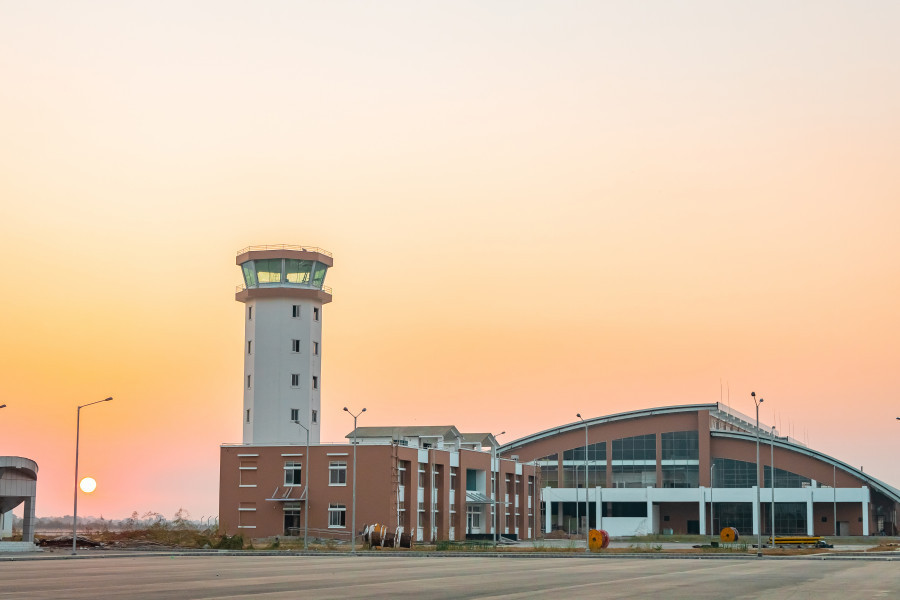Columns
An airport without airplanes
The conventional way of regulating airlines will not bring the desired outcome.
Mukesh Dangol
It has been a challenge to get international airlines to serve Gautam Buddha International Airport (GBIA) in Bhairahawa. Although the government has offered discounts on ground handling, landing and parking charges, only one airline from Kuwait was encouraged to fly to GBIA, and even that one airline did not last more than a few months. One year after the airport's gala opening, state-owned Nepal Airlines Corporation has grudgingly begun services between Bhairahawa and Kuala Lumpur. This will go down in Nepal's aviation history as a positive step towards guiding airport operation and creating a conducive aviation market. Will the national flag carrier's bold step attract foreign airlines and associated businesses?
GBIA was envisaged as a critical infrastructure and alternate aerodrome to Tribhuvan International Airport (TIA) in Kathmandu with the objective of transforming Lumbini, the birthplace of Lord Buddha and surrounding areas, into a religious, cultural and tourism destination. Located only 19 km from the UNESCO World Heritage Site of Lumbini, the airport was expected to catalyse economic growth in the region through improved connectivity.
Airport operators worldwide spend a considerable sum of money on marketing their facilities to attract airlines. Nevertheless, airline decisions are based on several aspects like market size, passenger preferences and demand, operating costs and pricing, regulation and external shocks.
Contrary to this, the conventional method of operating airports in Nepal which focuses on regulating airlines will not bring the desired outcome.
Airline's perspective
Airport operation and management involves proper business planning with customised airport business models that satisfy the needs of its key stakeholder airlines.
From an airline's perspective, the first question to consider when flying on a new route is whether there is enough demand—“demand forecasting”. They want to know how many passengers they will get by analysing the fares, routes, airlines and connections using aviation market intelligence tools. Airlines are reluctant to add new routes where uncertainty prevails.
Adding new routes is crucial to remaining profitable and competitive, but picking the wrong one could prove disastrous. Against a backdrop of the airline-airport nexus, what are the missing links? Does our conventional approach to airport operation and management cater to the needs of airlines? Some innovative approaches include freebies, risk sharing and private-public partnership (PPP) models.
Airlines have to pay for landing, parking, security and communication, among other services. In Nepal, these charges are guided by the Airport Service Charge Regulation 2022. Ground handling charges are a critical component in the operating cost. Air turbine fuel accounts for 30-40 percent of the operating cost. Jet fuel is high-priced in Nepal. Keeping these costs low or providing a 100 percent rebate on these charges reduces the cost per turn of airlines. Anything an airport can do to lower these costs will make it more attractive to airlines. If an airline can operate for less, they can charge lower fares to that airport, which creates more passengers. If the ticket price is high, fewer people will fly.
For any airline, establishing business in a new destination is an arduous job. That is why subsidies play a vital role in encouraging airlines during the initial years of airport operation because they can lower the risk for airlines entering new airports like GBIA. However, it is not justifiable for airlines to rely on subsidies alone for a very long time. Especially during the initial phase of airport operation, there are instances where airports share risks with airlines that serve those routes and destinations which still need to be operated. These long-term partnerships between airports and airlines, by transferring the risks, can result in a better outcome.
Nepal has signed Bilateral Air Service Agreements with 40 countries which provide ample traffic rights. They represent untapped opportunities for airlines to operate to GBIA. But the current conventional approach to operational modality needs to be improved to create a vibrant business-enabling environment for airlines. The mindset of airport operators which favours imposing stringent regulations without understanding the constraints airlines face won’t produce positive results. Hence, the existing modus operandi of airport management might require policy intervention.
Private sector participation
Private sector involvement in airport operation and management can be seen as an option. According to a 2016 study, private sector participation in airport management is significantly increasing. For instance, 15 percent of airports globally are fully privatised, 18 percent are operated and managed through public-private partnerships, while the remaining 67 percent have public ownership. Nevertheless, as of 2016, privatised or commercialised airports accounted for almost 50 percent of global airport passenger traffic.
In India, five major airports are run as public-private partnerships—Delhi, Mumbai, Hyderabad, Bangalore and Cochin. All have only minority public sector ownership.
Airports like GBIA require intervention at both policy and operational levels to run smoothly. It is high time the necessary steps were taken to operate GBIA sustainably. The present situation at the airport requires authorities to think out of the box. The huge investments in the project need to produce value for the nation's citizens. We should adopt innovative business models customised to our local environment.




 7.12°C Kathmandu
7.12°C Kathmandu















